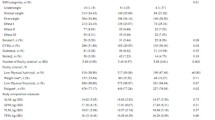Abstract
Objective
Prefrail and frail older adults are a heterogeneous population. The measurement of appendicular lean mass (ALM) may distinguish those at higher versus lower risk of poor outcomes. We examined the relationship between ALM and mortality among prefrail and frail older adults.
Design
This was a population-based cohort study.
Setting
The Third National Health and Nutrition Survey (NHANES III; 1988-1994).
Participants
Older adults (age ≥65 years) with pre-frailty or frailty defined using the Fried criteria.
Measurements
ALM was quantified using bioimpedance analysis. Multivariable-adjusted Cox regression analysis examined the relationship between ALM and mortality. Logistic regression analysis was used to determine if ALM added to age and sex improved the predictive discrimination of five-year and ten-year mortality.
Results
At baseline, the average age was 74.9 years, 66.7% were female, 86.3% and 13.7% were prefrail and frail, respectively. The mean ALM was 18.9 kg [standard deviation (SD): 5.5]. During a median 8.9 years of follow-up, 1,307 of 1,487 study participants died (87.9%). Higher ALM was associated with a lower risk of mortality. In a multivariable-adjusted regression model that accounted for demographic, behavioral, clinical, physical function, and frailty characteristics, each SD increase in ALM was associated with an 50% lower risk of mortality [Hazard Ratio: 0.50 (95% CI: 0.27-0.92); P=0.026]. The addition of ALM to age and sex improved the predictive discrimination of five-year (P=0.027) and ten-year (P=0.016) mortality.
Conclusion
ALM distinguishes the risk of mortality among prefrail and frail older adults. Additional research examining ALM as a therapeutic target is warranted.


Similar content being viewed by others
References
Gallagher D, Visser M, De Meersman RE, et al. Appendicular skeletal muscle mass: effects of age, gender, and ethnicity. J Appl Physiol (1985). 1997;83:229–239.
Auyeung TW, Lee SWJ, Leung J, Kwok T, Woo J. Age-associated decline of muscle mass, grip strength and gait speed: A 4-year longitudinal study of 3018 communitydwelling older Chinese. Geriatrics & gerontology international. 2014;14:76–84.
Kitamura I, Koda M, Otsuka R, Ando F, Shimokata H. Six-year longitudinal changes in body composition of middle-aged and elderly Japanese: Age and sex differences in appendicular skeletal muscle mass. Geriatrics & gerontology international. 2014;14:354–361.
Marzetti E, Leeuwenburgh C. Skeletal muscle apoptosis, sarcopenia and frailty at old age. Exp Gerontol. 2006;41:1234–1238.
Idoate F, Cadore EL, Casas-Herrero A, et al. Adipose tissue compartments, muscle mass, muscle fat infiltration, and coronary calcium in institutionalized frail nonagenarians. Eur Radiol. 2014:1–13.
Fried LP, Tangen CM, Walston J, et al. Frailty in older adults evidence for a phenotype. The Journals of Gerontology Series A: Biological Sciences and Medical Sciences. 2001;56:M146–M157.
Montero-Odasso M, Bergman H, Béland F, Sourial N, Fletcher JD, Dallaire L. Identifying mobility heterogeneity in very frail older adults. Are frail people all the same? Arch Gerontol Geriatr. 2009;49:272–277.
Plan and operation of the Third National Health and Nutrition Examination Survey, 1988-94. Series 1: programs and collection procedures. Vital Health Stat 1. 1994;(32):1–407.
Brown JC, Harhay MO, Harhay MN. The Prognostic Importance of Frailty in Cancer Survivors. J Am Geriatr Soc. 2015;2015;63:2538–2543.
Janssen I, Heymsfield SB, Baumgartner RN, Ross R. Estimation of skeletal muscle mass by bioelectrical impedance analysis. J Appl Physiol (1985). 2000;89:465–471.
Lukaski HC, Johnson PE, Bolonchuk WW, Lykken GI. Assessment of fat-free mass using bioelectrical impedance measurements of the human body. Am J Clin Nutr. 1985;41:810–817.
Baar Hv, Hulshof P, Tieland M, de Groot C. Bio-impedance analysis for appendicular skeletal muscle mass assessment in (pre-) frail elderly people. Clinical Nutrition ESPEN. 2015.
Rogot E, Sorlie P, Johnson NJ. Probabilistic methods in matching census samples to the National Death Index. J Chronic Dis. 1986;39:719–734.
National Center for Health Statistics. NHANES III Questionnaires, Datasets and Related Documentation. Available at: http://www.cdc.gov/nchs/nhanes/nh3data.htm.
Obisesan TO, Obisesan OA, Martins S, et al. High blood pressure, hypertension, and high pulse pressure are associated with poorer cognitive function in persons aged 60 and older: the Third National Health and Nutrition Examination Survey. J Am Geriatr Soc. 2008;56:501–509.
National Center for Health Statistics. Laboratory Procedures Used for the Third National Health and Nutrition Exam Survey (NHANES III), 1988-1994. Available at: http://wonder.cdc.gov/wonder/sci_data/surveys/hanes/hanes3/type_txt/lab.asp.
Lacher DA, Hughes JP, Carroll MD. Estimate of biological variation of laboratory analytes based on the third national health and nutrition examination survey. Clin Chem. 2005;51:450–452.
Guralnik JM, Simonsick EM, Ferrucci L, et al. A short physical performance battery assessing lower extremity function: association with self-reported disability and prediction of mortality and nursing home admission. J Gerontol. 1994;49:M85–94.
Korn EL, Graubard BI. Epidemiologic studies utilizing surveys: accounting for the sampling design. Am J Public Health. 1991;81:1166–1173.
Villareal DT, Smith GI, Sinacore DR, Shah K, Mittendorfer B. Regular multicomponent exercise increases physical fitness and muscle protein anabolism in frail, obese, older adults. Obesity. 2011;19:312–318.
Bibas L, Levi M, Bendayan M, Mullie L, Forman DE, Afilalo J. Therapeutic interventions for frail elderly patients: part I. Published randomized trials. Prog Cardiovasc Dis. 2014;57:134–143.
Cesari M, Vellas B, Hsu FC, et al. A Physical Activity Intervention to Treat the Frailty Syndrome in Older Persons-Results From the LIFE-P Study. J Gerontol A Biol Sci Med Sci. 2014.
Ferrucci L, Guralnik JM, Studenski S, Fried LP, Cutler GB, Walston JD. Designing randomized, controlled trials aimed at preventing or delaying functional decline and disability in frail, older persons: a consensus report. J Am Geriatr Soc. 2004;52:625–634.
Author information
Authors and Affiliations
Corresponding author
Rights and permissions
About this article
Cite this article
Brown, J.C., Harhay, M.O. & Harhay, M.N. Appendicular lean mass and mortality among prefrail and frail older adults. J Nutr Health Aging 21, 342–345 (2017). https://doi.org/10.1007/s12603-016-0753-7
Received:
Accepted:
Published:
Issue Date:
DOI: https://doi.org/10.1007/s12603-016-0753-7




